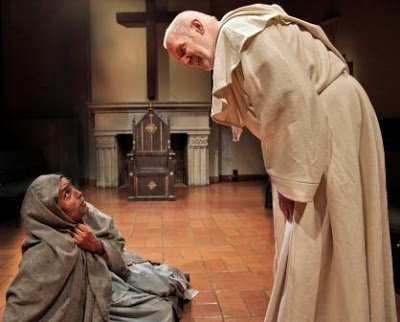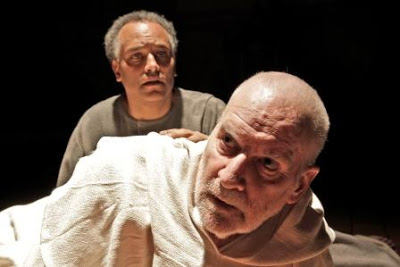
Just as some people believe that "size is everything," there are certain audiences who assume that the bigger and flashier the production placed before them, the greater its artistic value. Unfortunately, such is not always the case. Large-scale theatre and opera companies have been known to fill their stages with some whopping artistic turds that left audiences in a state of shock and awe.
Can great theatre be achieved without a multi-million dollar production? Without bombarding audiences with excruciating levels of amplification? Without famous actors? Without large casts wearing expensive costumes?
Yes, it can. For proof, there is no better place to go than Central Works, a tiny Berkeley theatre company that is now celebrating its 23rd season while maintaining some of the highest artistic standards in the Bay area. Having sung this company's praises on numerous occasions, there is always a concern that their "organic" approach to writing and producing a play might fail them. I'm happy to report that, like Cirque du Soleil, they continue to astonish and amaze me.

Poster art for The Grand Inquisitor
Central Works is currently reviving its 2005 production of The Grand Inquisitor with a sense of timeliness that is downright uncanny. When they first produced this play, Cardinal Joseph Ratzinger (who had occupied the office formerly known as the Holy Office of the Inquisition) was being elected to become Pope Benedict XVI. Shortly before this year's opening night, Pope Benedict announced that he would be relinquishing his title as the leader of the Roman Catholic church. News of his retirement was surrounded by lots of bad press and continued controversy over pedophilic priests and corruption in the Vatican.
Forget about trouble in River City. As so many have duly noted, "Exit Benedict."

Julian Lopez-Morrilas as the Grand Inquisitor
(Photo by: Jim Norrena)
Based on a parable in Fyodor Dostoyevsky's last novel (The Brothers Karamazov), The Grand Inquisitor offers audiences a remarkably insightful and riveting look at how absolute power corrupts absolutely. Written by Gary Graves and directed by Jan Zvaifler, the play is a tour de force for the actor (Julian Lopez-Morrilas) in the villainous title role. Set in Seville, Spain during the early 16th century, Dostoyevsky's Grand Inquisitor suffers from paranoid delusions, a severely overinflated sense of self-righteousness, and is the antithesis of what the Catholic church claims to be.
In short, there are voodoo dolls with a greater sense of integrity.
During the course of the play, the Grand Inquisitor must interact with four radically different people (all of whom are portrayed by the talented Michael Gene Sullivan).
- As the play starts, the Grand Inquisitor reaches out to his servant, Pedro, after suffering some kind of seizure in the Secreto (a room in the Palace of the Inquisition). Pedro informs the Grand Inquisitor that "He" has been spotted in town and that word is spreading that "He" has cured a beggar woman of her blindness.
- When the woman is brought before him, the Grand Inquisitor cross examines her and accuses her of being a liar and a fraud. She readily admits to faking blindness in order to feed herself but also speaks of the mysterious "He" who has arrived in town.

Michael Gene Sullivan and Julian Lopez-Morrilas
in The Grand Inquisitor (Photo by: Jim Norrena)
- The Grand Inquisitor's chief torturer is next to enter his chambers.
- Finally, the mysterious man who everyone else has referred to (identified only as "The Other" in the program) enters the chamber and, while maintaining his silence, acts as a foil to the Grand Inquisitor's agitated and increasingly terrified state. Is "He" truly a man of no importance or is "He" Jesus Christ, returned to earth? Is "He" really Satan trying to subvert the Grand Inquisitor's authority or is "He" a feverish figment of the paranoid old man's imagination?

Michael Gene Sullivan and Julian Lopez-Morrilas
in The Grand Inquisitor (Photo by: Jim Norrena)
This Central Works production is a magnificent example of what I like to call "The Black Box Theatre of Minimalism." Not only does The Grand Inquisitor offer Bay area audiences two powerful performances in a tiny space that seats only 50 people, this production builds to a riveting dramatic confrontation that is the essence of politically relevant theatre. The writing is lean, mean, and brilliantly executed by Michael Gene Sullivan and Julian Lopez-Morrilas.
Kudos to Gary Graves (who also designed the hellish lighting) and Gregory Scharpen, whose sound design is, as always, electrifying. Midway through the performance, as I watched Julian Lopez-Morrilas writhing in agony on the floor, I leaned against a rail and stopped for a second to think that "Most people right now are sitting at home watching the Oscars. But I'm here at the Berkeley City Club with 40 other people enjoying a much better show!"
To read more of George Heymont go to My Cultural Landscape
